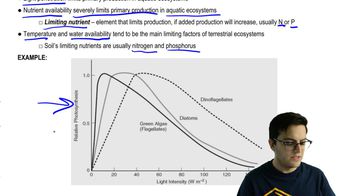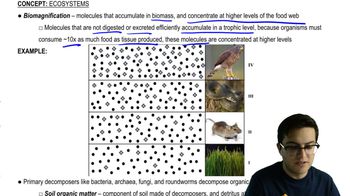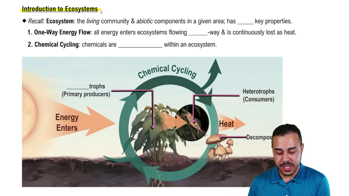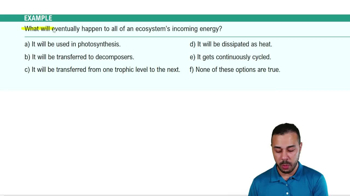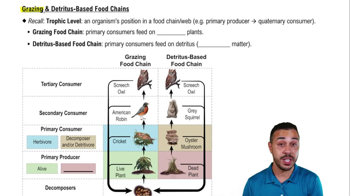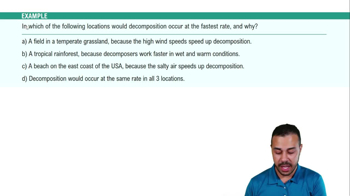Table of contents
- 1. Introduction to Biology2h 42m
- 2. Chemistry3h 40m
- 3. Water1h 26m
- 4. Biomolecules2h 23m
- 5. Cell Components2h 26m
- 6. The Membrane2h 31m
- 7. Energy and Metabolism2h 0m
- 8. Respiration2h 40m
- 9. Photosynthesis2h 49m
- 10. Cell Signaling59m
- 11. Cell Division2h 47m
- 12. Meiosis2h 0m
- 13. Mendelian Genetics4h 44m
- Introduction to Mendel's Experiments7m
- Genotype vs. Phenotype17m
- Punnett Squares13m
- Mendel's Experiments26m
- Mendel's Laws18m
- Monohybrid Crosses19m
- Test Crosses14m
- Dihybrid Crosses20m
- Punnett Square Probability26m
- Incomplete Dominance vs. Codominance20m
- Epistasis7m
- Non-Mendelian Genetics12m
- Pedigrees6m
- Autosomal Inheritance21m
- Sex-Linked Inheritance43m
- X-Inactivation9m
- 14. DNA Synthesis2h 27m
- 15. Gene Expression3h 20m
- 16. Regulation of Expression3h 31m
- Introduction to Regulation of Gene Expression13m
- Prokaryotic Gene Regulation via Operons27m
- The Lac Operon21m
- Glucose's Impact on Lac Operon25m
- The Trp Operon20m
- Review of the Lac Operon & Trp Operon11m
- Introduction to Eukaryotic Gene Regulation9m
- Eukaryotic Chromatin Modifications16m
- Eukaryotic Transcriptional Control22m
- Eukaryotic Post-Transcriptional Regulation28m
- Eukaryotic Post-Translational Regulation13m
- 17. Viruses37m
- 18. Biotechnology2h 58m
- 19. Genomics17m
- 20. Development1h 5m
- 21. Evolution3h 1m
- 22. Evolution of Populations3h 52m
- 23. Speciation1h 37m
- 24. History of Life on Earth2h 6m
- 25. Phylogeny2h 31m
- 26. Prokaryotes4h 59m
- 27. Protists1h 12m
- 28. Plants1h 22m
- 29. Fungi36m
- 30. Overview of Animals34m
- 31. Invertebrates1h 2m
- 32. Vertebrates50m
- 33. Plant Anatomy1h 3m
- 34. Vascular Plant Transport1h 2m
- 35. Soil37m
- 36. Plant Reproduction47m
- 37. Plant Sensation and Response1h 9m
- 38. Animal Form and Function1h 19m
- 39. Digestive System1h 10m
- 40. Circulatory System1h 57m
- 41. Immune System1h 12m
- 42. Osmoregulation and Excretion50m
- 43. Endocrine System1h 4m
- 44. Animal Reproduction1h 2m
- 45. Nervous System1h 55m
- 46. Sensory Systems46m
- 47. Muscle Systems23m
- 48. Ecology3h 11m
- Introduction to Ecology20m
- Biogeography14m
- Earth's Climate Patterns50m
- Introduction to Terrestrial Biomes10m
- Terrestrial Biomes: Near Equator13m
- Terrestrial Biomes: Temperate Regions10m
- Terrestrial Biomes: Northern Regions15m
- Introduction to Aquatic Biomes27m
- Freshwater Aquatic Biomes14m
- Marine Aquatic Biomes13m
- 49. Animal Behavior28m
- 50. Population Ecology3h 41m
- Introduction to Population Ecology28m
- Population Sampling Methods23m
- Life History12m
- Population Demography17m
- Factors Limiting Population Growth14m
- Introduction to Population Growth Models22m
- Linear Population Growth6m
- Exponential Population Growth29m
- Logistic Population Growth32m
- r/K Selection10m
- The Human Population22m
- 51. Community Ecology2h 46m
- Introduction to Community Ecology2m
- Introduction to Community Interactions9m
- Community Interactions: Competition (-/-)38m
- Community Interactions: Exploitation (+/-)23m
- Community Interactions: Mutualism (+/+) & Commensalism (+/0)9m
- Community Structure35m
- Community Dynamics26m
- Geographic Impact on Communities21m
- 52. Ecosystems2h 36m
- 53. Conservation Biology24m
52. Ecosystems
Introduction to Ecosystems
Problem 6`
Textbook Question
Which of the following was a result of the Hubbard Brook watershed deforestation experiment?
a. Most minerals were not recycled within the intact forest ecosystem
b. Calcium levels remained high in the soil of deforested areas
c. Deforestation decreased water runoff
d. The nitrate concentration in waters draining the deforested area became dangerously high
 Verified step by step guidance
Verified step by step guidance1
Understand the context of the Hubbard Brook watershed deforestation experiment, which was designed to study the effects of deforestation on ecosystem nutrient cycles and water runoff.
Recall that deforestation can lead to increased water runoff because trees and vegetation that normally absorb water are removed, leading to more water flowing into streams and rivers.
Consider the role of trees and vegetation in nutrient cycling. In an intact forest, trees absorb nutrients from the soil, and these nutrients are recycled back into the ecosystem through processes like leaf litter decomposition.
Recognize that without trees, nutrients such as nitrates are not absorbed and recycled effectively, leading to higher concentrations of these nutrients in water draining from the deforested area.
Conclude that the correct result of the Hubbard Brook experiment is that the nitrate concentration in waters draining the deforested area became dangerously high, which corresponds to option (D).
 Verified video answer for a similar problem:
Verified video answer for a similar problem:This video solution was recommended by our tutors as helpful for the problem above
Video duration:
3mPlay a video:
Was this helpful?
Key Concepts
Here are the essential concepts you must grasp in order to answer the question correctly.
Nutrient Cycling in Ecosystems
Nutrient cycling refers to the movement and exchange of organic and inorganic matter back into the production of living matter. In intact forest ecosystems, nutrients like nitrogen and calcium are recycled efficiently, maintaining soil fertility and ecosystem stability. Disruption, such as deforestation, can interrupt these cycles, leading to nutrient loss and environmental imbalance.
Recommended video:
Guided course

Soil Nutrients
Impact of Deforestation on Soil and Water
Deforestation significantly affects soil and water dynamics by removing vegetation that stabilizes soil and regulates water flow. Without trees, soil erosion increases, and water runoff can carry away essential nutrients, leading to elevated concentrations of substances like nitrates in nearby water bodies, which can be harmful to aquatic life and water quality.
Recommended video:
Guided course

Water Potential in Soil and Air
Nitrate Pollution
Nitrate pollution occurs when excess nitrates, often from agricultural runoff or deforestation, enter water systems, leading to eutrophication. This process can cause algal blooms, deplete oxygen levels, and harm aquatic ecosystems. In the Hubbard Brook experiment, deforestation led to increased nitrate levels in water, highlighting the importance of vegetation in nutrient retention.
Recommended video:
Guided course

Pollution and Climate Change

 4:07m
4:07mWatch next
Master Introduction to Ecosystems with a bite sized video explanation from Jason
Start learningRelated Videos
Related Practice





